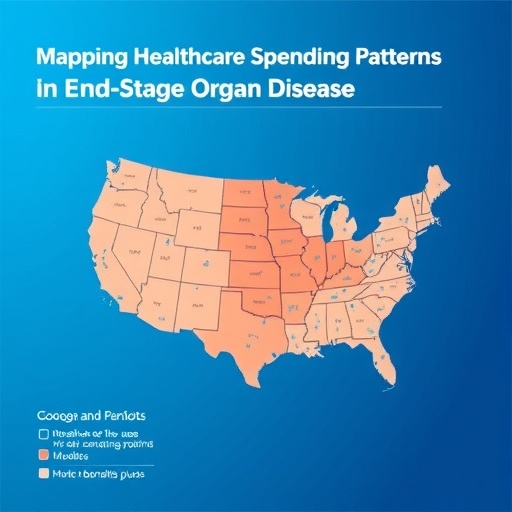In a groundbreaking study that delves into the complexities of healthcare expenditure, researchers have identified distinct patterns of spending associated with end-stage organ disease, particularly within the unique context of Singapore’s healthcare landscape. Conducted by a team led by Ng, SX, this retrospective cohort study leverages linked administrative databases to reveal clusters of healthcare expenditure trajectories. The importance of this research lies not only in its capacity to illuminate spending behaviors but also in its potential to enhance the efficiency of healthcare resource allocation in an era marked by escalating healthcare costs.
End-stage organ disease presents a significant challenge to healthcare systems globally, characterized by advanced deterioration of organ function and the necessity for expensive interventions, including dialysis and potential organ transplantation. As such, understanding the financial trajectory and expenditure related to these conditions is vital for policymakers, healthcare providers, and researchers alike. The study’s findings suggest that recognizing expenditure patterns could lead to more strategic decision-making regarding resource distribution and patient care approaches.
The methodology employed by the research team was methodologically robust, drawing on comprehensive administrative data that spans patient demographics, clinical pathways, and financial records. By linking various datasets, the researchers were able to create a thorough picture of the healthcare journey experienced by patients with end-stage organ disease. This approach not only strengthens the validity of their findings but also highlights the importance of comprehensive data integration in health economics research.
One of the most striking results of the study was the identification of specific clusters of expenditure trajectories. These clusters revealed how different patient characteristics, including age, gender, and comorbidities, influence healthcare spending. For instance, older patients or those with multiple health conditions tended to exhibit markedly different expenditure patterns compared to younger, less complex cases. This insight is pivotal, as it underscores the necessity for personalized healthcare strategies and targeted interventions that address these underlying variables.
The implications of understanding healthcare expenditure trajectories are profound. By identifying high-cost clusters, healthcare systems can implement preemptive measures aimed at reducing future spending. Early intervention strategies, such as regular monitoring and tailored care plans, could significantly diminish acute care needs and improve patient outcomes. The study emphasizes that proactive management and resource allocation based on expenditure patterns could not only ease the burden on healthcare systems but also lead to better quality of life for patients.
Furthermore, this research adds to the growing body of evidence that underscores the critical need for integrated care models. When healthcare providers adopt a holistic approach that considers both clinical and financial aspects of patient care, they can enhance collaboration across multidisciplinary teams. This study serves as a clarion call to rethink how healthcare is delivered, advocating for systems that prioritize comprehensive patient management rather than fragmented, episode-based care.
The findings of this study are particularly timely in light of the current global healthcare challenges, including the COVID-19 pandemic, which has underscored vulnerabilities within various health systems. As healthcare expenditures continue to rise, it is imperative that strategies are implemented to optimize resource use. This research provides a valuable framework for understanding how expenditures can be better aligned with patient needs and outcomes, potentially transforming the landscape of healthcare delivery.
In addition to the immediate clinical insights, there are broader economic implications to consider. By understanding expenditure trajectories, policymakers can develop more effective budgetary frameworks, allowing for informed predictions of future spending. This aspect of the research reinforces the interconnected nature of healthcare delivery, economy, and policy, highlighting the need for a coordinated approach that encompasses all stakeholders in the healthcare ecosystem.
What’s more, the analytical techniques utilized in this study could serve as a model for future research endeavors. The methodologies employed to cluster expenditure trajectories may be applied to other areas of healthcare services, providing a template for researchers looking to better understand the financial dynamics of various health conditions and treatment modalities. This potential for cross-application underscores the versatility and relevance of the study’s findings.
Importantly, as healthcare systems worldwide grapple with the question of sustainability, findings such as those presented in Ng et al.’s research offer a beacon of hope. The identification of expenditure trends not only contributes to more efficient healthcare system operations but also promotes equity in healthcare access by ensuring that resources are appropriated based on need and effectiveness rather than historical biases or arbitrary allocations.
In summation, Ng, SX., Kaur, P., and Tan, L.’s study represents a significant advancement in our understanding of healthcare expenditure related to end-stage organ disease. The integration of linked administrative databases to reveal spending clusters offers practical implications for both clinical practice and health policy formulation. As the world moves toward more data-driven healthcare models, such research will be critical in shaping systems that balance quality care with financial sustainability, ultimately improving outcomes for patients with complex health needs.
Efforts to translate these findings into actionable healthcare policy will be paramount. As the dialogue around healthcare reform continues, integrating research insights into practical applications will require collaboration across various sectors, including clinical, administrative, and policy-making environments. The pathway forward is clear: leveraging data to inform healthcare spending decisions will not only benefit patients but also empower healthcare systems to navigate the increasingly complex terrain of modern medical care effectively.
The potential for future studies to build upon Ng et al.’s work is vast. With the constant evolution of patient demographics and healthcare technologies, continued research is essential in understanding how expenditure patterns might shift over time. The anticipated growth of chronic diseases and aging populations will likely necessitate ongoing investigation into effective expenditure management.
As a collaborative effort between researchers, clinicians, policymakers, and patients, the future of healthcare spending management holds promise. By fostering an environment of shared knowledge and collective action, we can pave the way for a healthcare system that values patients’ needs while navigating the financial realities of contemporary medicine. Ultimately, the focus on expenditure trajectories equips all stakeholders with the tools necessary to enact meaningful change.
Subject of Research: Healthcare expenditure trajectories in end-stage organ disease.
Article Title: Identifying clusters of healthcare expenditure trajectories in end-stage organ disease: a retrospective cohort study using linked administrative databases in Singapore.
Article References: Ng, SX., Kaur, P., Tan, L. et al. Identifying clusters of healthcare expenditure trajectories in end-stage organ disease: a retrospective cohort study using linked administrative databases in Singapore. BMC Health Serv Res 25, 1403 (2025). https://doi.org/10.1186/s12913-025-13590-z
Image Credits: AI Generated
DOI:
Keywords: Healthcare expenditure, end-stage organ disease, administrative databases, healthcare policy, resource allocation.
Tags: administrative databases in healthcare researchdialysis and organ transplantation expensesend-stage organ disease costsfinancial trajectories in healthcarehealthcare expenditure analysishealthcare resource allocationhealthcare spending patternshealthcare system challengespatient care approaches for end-stage diseaseretrospective cohort study in healthcareSingapore healthcare expenditurestrategic decision-making in healthcare





